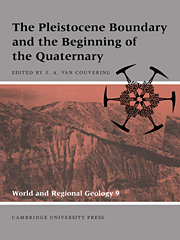Book contents
- Frontmatter
- Contents
- List of contributors
- Preface: the new Pleistocene
- Foreword
- Part I Definition of the base of the Quaternary
- Part II Characterization of the Pleistocene boundary-stratotype
- 2 The Pliocene–Pleistocene boundary-stratotype at Vrica, Italy
- 3 The magnetostratigraphy of the Vrica section, Italy, and its correlation with the Plio–Pleistocene of the Boso Peninsula, Japan
- 4 Comparison of the laminated units at Vrica and deep-sea sapropels from the eastern Mediterranean
- 5 Calcareous nannofossil biochronology and the Pliocene–Pleistocene boundary
- 6 Diatom microfossils from the Vrica section
- Part III The paleontological context of the Pleistocene boundary
- Part IV The Pleistocene boundary in regional sequences
- Index
5 - Calcareous nannofossil biochronology and the Pliocene–Pleistocene boundary
Published online by Cambridge University Press: 10 November 2009
- Frontmatter
- Contents
- List of contributors
- Preface: the new Pleistocene
- Foreword
- Part I Definition of the base of the Quaternary
- Part II Characterization of the Pleistocene boundary-stratotype
- 2 The Pliocene–Pleistocene boundary-stratotype at Vrica, Italy
- 3 The magnetostratigraphy of the Vrica section, Italy, and its correlation with the Plio–Pleistocene of the Boso Peninsula, Japan
- 4 Comparison of the laminated units at Vrica and deep-sea sapropels from the eastern Mediterranean
- 5 Calcareous nannofossil biochronology and the Pliocene–Pleistocene boundary
- 6 Diatom microfossils from the Vrica section
- Part III The paleontological context of the Pleistocene boundary
- Part IV The Pleistocene boundary in regional sequences
- Index
Summary
Introduction
Calcareous nannofossils are microscopic skeletal elements of calcite produced by planktic unicellular algae, occurring abundantly in marine sediments from the Jurassic to the present. The rapid evolution of the nannofossils through time has been used to establish highly resolved biostratigraphic zonations, particularly for the Cretaceous and Cenozoic eras (e.g., Martini, 1971; Thierstein, 1976; Roth, 1978; Bukry, 1978). The zonal boundaries are defined by extinctions or first appearances of individual species, and such datum events have been found to have occurred synchronously on a global scale, when calibrated against oxygen-isotope stratigraphy (e.g., Thierstein et al., 1977) or against magnetostratigraphy (e.g., Backman and Shackleton, 1983).
Nannofossils are well represented in the Pliocene and Lower Pleistocene marine deposits in Italy, and therefore they provide a means by which this regional geologic record can be correlated with extra-Mediterranean areas (Figure 5.1). This possibility of correlation is important because the type regions of the Pliocene and the Pleistocene are located in Italy (Lyell, 1833; Berggren, 1972).
In this chapter we shall briefly review the development of nannofossil biostratigraphy at the Pliocene–Pleistocene transition, as derived from deep-sea sediments and regions in Italy. Second, we shall present the biochronology of critical nannofossil datum events. Third, we shall insert the regional Italian lithostratigraphic record into the established nannofossil biostratigraphic-biochronologic framework and estimate the age of the physical horizon that has been proposed by INQUA Subcommission 1-d, “Pliocene/Pleistocene Boundary,” to be used as the definition of the Pliocene–Pleistocene boundary in the Vrica section, Calabria.
This chapter was submitted essentially in its present form in 1985, when two of us (D.R. and I.R.) were at the Istituto di Geologia, Università di Parma.
- Type
- Chapter
- Information
- Publisher: Cambridge University PressPrint publication year: 1996
- 4
- Cited by



